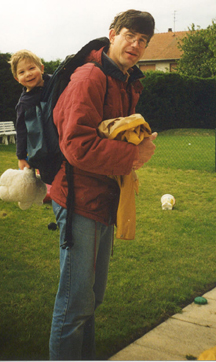
Figure:
Micropaleontology needs a powerful next generation...
|
Michael
Knappertsbusch Michael Knappertsbusch is curator for micropaleontology at the Natural History Museum in Basel. He studied geology at the Federal Institute of Technology (ETH) in Zürich, Switzerland, and graduated in 1986 with a diploma thesis entitled "Biostratigraphy, lithostratigraphy and sedimentology of the Maiolica Lombarda and the Scaglia Lombarda on the west side of Lake Garda (Northern Italy)". In 1990 he obtained a PhD in Geology from ETH with the title "Modern coccolithophorids in the Mediterranean Sea and morphological evolution of Calcidiscus leptoporus". From 1990 to 1994 he was at the Free University of Amstrdam, the Netherlands, where he collaborated as a post-doc in the "Global Emiliania Modelling Initiative". |
| During
this international research program he investigated the significance of marine
phytoplankton in the global carbon cycle in the case of the living
coccolithophorid Emiliania huxleyi. During that time Michael
Knappertbusch studied the biogeography, flux, and accumulation of extant
coccolithophorids mainly in the North Atlantic, which ended in a computer
simulation of Emiliania huxleyi blooms by Michael Knappertsbusch.
Since 1994 he has been employed as curator for micropaleontology at the Natural History Museum in Basel and is responsible for the collections of the West-European Micropaleontological Reference Center of the DSDP and ODP, that are held there. He teaches micropaleontology at the Geological Institute of the University of Basel, and his main research interests are the evolution and the biogeography of speciation patterns of oceanic microfossils (coccolithophorids and planktic foraminifera). For this purpose he develops advanced tools for morphometric investigations and visualization techniques for microfossils on the computer. Michael's current work is about the morphological evolution of Neogene planktic foraminifera (Globorotalia menardii and Globorotalia tumida) from deep-sea cores from both sides of the Central American landbridge by means of digital image analysis. Another field of activity is a standardized compilation and synthesis of worldwide biostratigraphic datums from Cenozoic sediments, that are available from the Initial and Scientific Reports of the DSDP and ODP, and the development of computerized tools for numerical age modelling and micropaleontological databases. |
|